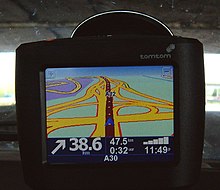Turn-by-turn navigation
Turn-by-turn navigation is a feature of some satellite navigation devices where directions for a selected route are continually presented to the user in the form of spoken or visual instructions.
[1] The system keeps the user up-to-date about the best route to the destination, and is often updated according to changing factors such as traffic and road conditions.
[3] Mathematically, turn by turn navigation is based on the shortest path problem within graph theory, which examines how to identify the path that best meets some criteria (shortest, cheapest, fastest, etc.)
Real-time turn-by-turn navigation instructions by computer was first developed at the MIT Media Laboratory by James Raymond Davis and Christopher M. Schmandt in 1988.
[4] Their system, Backseat Driver, monitored the car's position using a system developed by NEC that communicated over a cellular modem with software running on a Symbolics LISP Machine at the Media Lab.

